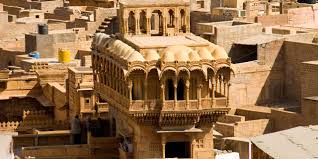Salim Singh Ki Haveli: A Marvel of Jaisalmer’s Architecture and Heritage
Located in the golden city of Jaisalmer, Rajasthan, Salim Singh Ki Haveli stands as one of the most remarkable and elegant structures that reflect the rich cultural and architectural heritage of the region. A grand mansion dating back to the 17th century, Salim Singh Ki Haveli is an essential stop for anyone exploring the vibrant city of Jaisalmer. Its unique design, historical significance, and the stories surrounding it make it a fascinating destination for tourists. This article explores the haveli's architectural features, history, and the experiences that make it a must-visit while in Jaisalmer.
1. Historical Background of Salim Singh Ki Haveli
Salim Singh Ki Haveli was constructed in the 17th century by Salim Singh, the prime minister of Jaisalmer under the rule of Maharawal Jaisal Singh. The haveli was built as a luxurious residence for Salim Singh, a man known for his wealth and influence. As a minister in the royal court, Salim Singh was granted the privilege to build a residence that would reflect his stature and power.
The haveli was not just a residence; it also served as a symbol of the opulence and prosperity of Jaisalmer’s merchant class during its golden age. The city, famous for its camel trade and strategic location along the Silk Route, had a flourishing economy, and Salim Singh's wealth allowed him to build one of the most magnificent havelis in the region.
2. Architectural Splendor of Salim Singh Ki Haveli
One of the key reasons why Salim Singh Ki Haveli attracts tourists is its striking and unique architectural style. The haveli is constructed using golden-yellow sandstone, which blends seamlessly with the surrounding desert landscape, giving it a radiant golden appearance, especially during sunset.
The haveli is known for its distinctively shaped roof, which is designed to resemble a peacock, a motif common in Rajput architecture. This unusual design sets Salim Singh Ki Haveli apart from other havelis in Jaisalmer. The roof is adorned with intricately carved wooden brackets that resemble the outstretched wings of a peacock, symbolizing grace and beauty. This unique feature has made the haveli one of the most photographed landmarks in Jaisalmer.
The haveli itself is a multi-storied structure, featuring several rooms and courtyards, each more impressive than the last. The architecture of the haveli is a beautiful blend of Rajput and Islamic styles, with delicate carvings, arched windows, and jharokhas (overhanging enclosed balcony windows) that provide stunning views of the city.
The interior of the haveli is equally enchanting, with exquisitely painted walls, ceilings, and intricate carvings of flowers, animals, and geometric patterns. The wooden window frames and intricately designed arches showcase the fine craftsmanship of the time. Many of the rooms contain large wooden pillars, giving the haveli a regal feel.
3. Historical Significance and Legends
Salim Singh Ki Haveli is not only an architectural marvel but also steeped in history and legend. The stories about Salim Singh himself add an air of mystery and intrigue to the haveli. It is said that Salim Singh was a controversial and powerful figure in Jaisalmer’s royal court, known for his extravagant lifestyle and cunning political maneuvers.
There are also many myths surrounding the construction of the haveli. Some say that Salim Singh’s extravagant wealth caused envy among the locals, leading to rumors that his money was acquired through underhanded methods. Another legend suggests that the original design of the haveli was much grander, but it had to be scaled back due to a curse placed on the building by the royal family of Jaisalmer, who disapproved of Salim Singh’s behavior.
One of the most fascinating stories surrounding Salim Singh Ki Haveli is that Salim Singh, with his wealth and power, had hoped to control the water resources of the region. According to some accounts, the haveli was designed in a way that it could collect rainwater from the roof and channel it into a reservoir below the building.
4. Touring Salim Singh Ki Haveli
Visiting Salim Singh Ki Haveli offers tourists a chance to step back in time and experience the grandeur of Jaisalmer’s royal past. The haveli is located in the heart of the city, near the famous Patwon Ki Haveli, another iconic architectural gem in Jaisalmer. The haveli is a popular stop for tourists on their way to other attractions in the city.
Upon arrival, visitors are greeted by the haveli’s majestic sandstone façade, which is beautifully adorned with intricate carvings. Inside, the haveli showcases multiple rooms, courtyards, and balconies, each exuding the charm of Rajasthan’s royal heritage. The central courtyard, with its ornate arches and sculptures, is an excellent place for visitors to take in the intricate details of the architecture.
Guided tours are available, offering visitors the opportunity to learn about the haveli’s history and the legacy of Salim Singh. These tours often include stories about the life and times of Salim Singh, as well as insights into the architectural details of the building. One of the highlights of the visit is the chance to admire the stunning peacock-shaped roof and learn about its symbolic significance.
5. The Experience of Visiting Salim Singh Ki Haveli
A visit to Salim Singh Ki Haveli is not just about admiring the building’s stunning architecture; it is also about immersing oneself in the rich history and culture of Jaisalmer. The haveli is a reminder of a bygone era, when the city was a center of commerce, politics, and opulence. The calm and serene atmosphere within the haveli offers a stark contrast to the bustling streets outside.
For photographers, the haveli presents endless opportunities for capturing the exquisite beauty of Jaisalmer’s architecture. The play of light and shadow on the sandstone walls, the intricate carvings, and the stunning details of the peacock roof are sure to be highlights in any photo collection.

Comments
Post a Comment